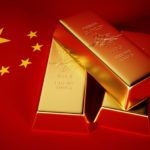The fiction in Chinese gold reserves and media import coverage
(October 9, 2017 - by Lawrie Williams)
According to the People’s Bank of China – the country’s central bank – the Asian economic giant’s gold reserves have now remained unchanged for 11 straight months - indeed ever since the nation’s currency – the yuan or reminbi – was admitted by the IMF as an integral constituent of that entity’s Special Drawing Right (SDR). This acceptance was a key step towards making the yuan acceptable as a reserve currency around the globe. And in the 16 months leading up to this China reported its gold reserve increases monthly – in the interests of transparency. Since then – somewhat cynically we believe – the country has reverted to reporting zero increases month-by-month.
While it is unlikely to unseat the U.S. dollar as the world’s principal reserve currency in the short term, China has already been making moves to make the yuan an integral constituent of certain trade deals, notably as acceptable payment currency for its huge oil imports – particularly so as it is prepared to facilitate the exchange of its yuan payments for gold tradable on a Chinese exchange, thus bypassing the petrodollar in which all payments for oil had been made in the past.
But while its ‘official’ gold reserve figure remains unchanged there is increasing belief that this figure is a fiction, and its true gold reserves are considerably higher – which might indeed be deemed necessary if it is effectively to finance its oil purchases with gold, albeit indirectly. The country has a history of only announcing its gold reserve accumulations at several year intervals claiming that this additional reserve gold had been held in a separate account which it did not need to declare to the IMF as it was not actually a constituent part of its official forex reserve – a question of semantics at best.
Some estimates by gold analysts put the true Chinese gold reserve figure as 5,000 tonnes, or higher and there is a wide belief that it has a policy to build oits gold reserve to a level which is higher that the U.S. official gold reserve figure of 8,133.5 tonnes. China currently only reports a gold reserve of 1,842.6 tonnes.
China is the world’s largest gold producer, so has available around 450 tonnes of domestic gold annually which it could be absorbing into its reserves without it appearing in any global gold trade figures. There is also anecdotal evidence of other unreported gold shipments into the Chinese mainland, while adding together known gold imports from countries/regions which report them – notably Switzerland, the UK, Australia, the USA and Hong Kong the country appears to take in considerably more gold each year than estimates of domestic consumption by the major gold consultancies would suggest. A fair amount of this ‘excess’ gold appears to be held within the country’s commercial banking system, but given the commercial banks are state-owned these holdings might also be considered a part of the nation’s total gold reserve.
There have also, though, been some pretty dramatic headlines suggesting Chinese gold imports in August were enormously down on previous months – based on Hong Kong figures which for many years were considered a proxy for total Chinese gold imports. Well it is true that gold imports from Hong Kong were at the lowest level for some time that m,onth, BUT, it is also becoming increasingly apparent that gold imports going into the Chinese mainland directly, thus avoiding Hong Kong altogether, are becoming more and more significant.
As an example, Switzerland is the world’s largest exporter of refined bullion into the Asian markets. Year to date this nation’s refineries have exported 205.5 tonnes of gold to mainland China directly and only 162.5 tonnes to Hong Kong. If we take last December’s figure there was even more of an anomaly with 154 tonnes of gold going to the Chinese mainland directly and only 39 tonnes to Hong Kong. This all shows why the Hong Kong net figures can no longer be seen as a proxy for Chinese gold imports. Certainly, as far as Switzerland is concerned – the primary source of imported gold to China and Hong Kong - well over half is now going directly to the mainland!






